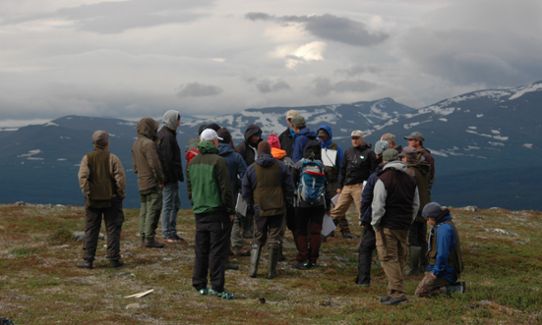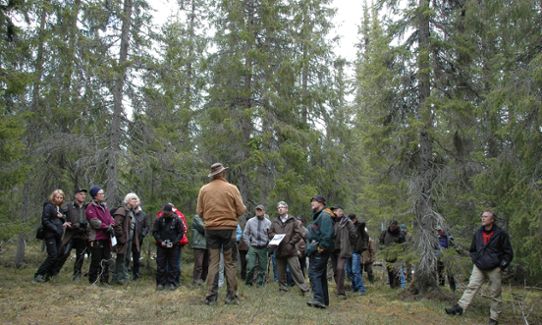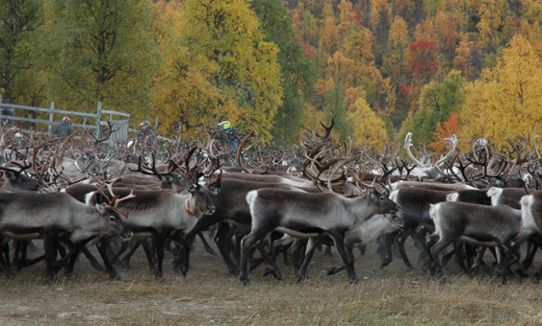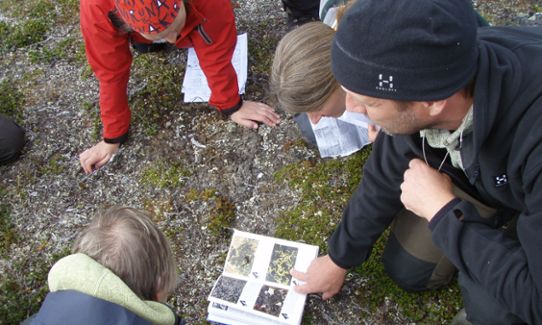Climate change is already noticeable in Vilhelmina Municipality today, and it will continue to affect most people very strongly. The tree line is moving up the mountain, and mushrooms and pests are growing. The reindeer grazing areas are being affected. With less frozen ground, the bearing capacity of the ground is changing, which affects transports both in the forests and on roads.
Adapting to the changes requires broad collaboration between a large number of different actors, and mainly at the local level. Forestry, reindeer husbandry, the mining industry, wind power, municipality and county administrative board are a few of those who need to cooperate to bring up and address conflicts of interest, and to see new possibilities.

Broad arena for collaboration
Since 2004, the non-profit network Vilhelmina Model Forest has been operating with the aim of achieving a long-term sustainable use of the landscape in the municipality, based on local cooperation and collaboration. The basic idea of the concept is that the users of the landscape should find ways to combine the local community’s social, cultural and financial needs with long-term ecological sustainability in large landscapes.
Vilhelmina Model Forest is a broad arena for gathering actors that might not meet otherwise. Here, work groups are created with the right expertise for varying issues. An important aspect is also knowledge exchange, both with a broader public, but also with different areas of research. The steering group includes representation from the municipality, the Swedish Forest Agency, reindeer husbandry, the Swedish University of Agricultural Sciences, geology specialists, culture and tourism interests, and hunting and educational interests. One group of stakeholders consists of a large number of local representatives for various land use interests. An extensive contact network has also been created with people and organisations that in one way or other are interested in ongoing activities.

What does Vilhelmina Model Forest work with?
The field of work is very broad. Among other things, 15 demonstration areas were built up to present themes, such as alternative forest management methods, restoration of rivers and Sami cultural trails. Important issues that permeate the work in the Vilhelmina Model Forest are climate, reindeer husbandry, water and geographic information systems as tools for the planning of land use.
One concrete example of the activities are plans for reindeer herding that strengthen the consultation situation between the reindeer breeding industry and forestry in the form of a reindeer husbandry plan. Another is work in the area of “Clear-cut Free”, which aims to find solutions for using the forest in a way other than clear-cutting an area. Vilhelmina Model Forest was one of the driving actors for beginning the municipality’s vulnerability analysis.
Reindeer husbandry plan (Sami Parliament, in Swedish)
A changed climate is expected to lead to periodically more water in the rivers, which benefits biological diversity and ecosystem services, such as fishing and recreation along the rivers. The Ångermanälv River project, within the scope of Vilhelmina Model Forest, has prepared three detailed reports since 2009 where a large number of possible efforts are proposed along the river to create free migration routes for fish, manage the minimum flows and restore flows in dry furrows. Discussions are being held with the power companies to develop the river’ natural assets in coexistence with hydro power. More than 40 per cent of the measures are estimated to not cost anything in power production. Report in English.
A demonstration room in the Vilhelmina urban area presents the entire operation – ranging from what the concept is based on to various cooperative partners and what is happening in various projects. The idea of the demonstration room is that it should be a place for spreading information and knowledge about land use and about the way towards sustainable development.
Vilhelmina Model Forest originated from the Canadian Model Forest network. The basic idea is that users in a large-scale landscape try to find ways to achieve long-term ecological sustainability. The emphasis has been on indigenous populations, with the desire to compare and learn from each other about culture, current living conditions and future challenges and development opportunities. Vilhelmina Model Forest was the first European network in the collaboration. Examples of exchange are teaching about climate adaptation, where Canadian researchers have shared their knowledge.

Financing
The various stakeholders in Vilhelmina Model Forest contribute their own time and there is no fixed financing. The long list of projects conducted since the beginning has been financed with various funds, such as funding from the rural area programme and other EU funding.
Opportunities
Vilhelmina Model Forest is a neutral organisation and has thereby become an arena for all actors, regardless of opinions or own interests. It creates opportunities for dialogues over borders, a meeting place that exists nowhere else. Through the large network, access to expertise is offered in a very broad area, which means that working groups can be created for all current issues.
Thanks to the broad activities conducted over many years, a well-known name has been built up in the area, which is a good platform for financing, new research projects and creating new contacts. The flexibility and local ties provide a foundation for finding solutions to climate adaptation problems and innovative cross-industry solutions. The close ties to research also add continuous knowledge.

Challenges
The activity level has varied over the years that activities have been conducted. In general, it can be said that current financing for various projects has largely determined the scope. A long-term approach is something that is strived for in the entire concept, as well as clear goals and visions. Creating concepts of this kind takes a very long time.
Today, the activities build on enthusiasts driving issues further, making development dependent on individuals and also more vulnerable. Sometimes, the network is perceived to come second to the representatives’ main occupations. Many feel that the organisation must continuously be kept alive with regular physical meetings, and that the communication work is of crucial significance.
Vilhelmina Model Forest is not a legal entity, which is something being discussed to make it easier, for example, to seek funding.
More examples of climate adaptation
This is one of many examples of climate adaptation. There are more in the collection of ideas being built up by the Swedish National Knowledge Centre for Climate Change Adaptation at the Swedish Meteorological and Hydrological Institute (SMHI). The collection of examples has the aim of sharing experiences and providing ideas to everyone who works with climate adaptation. Examples describe concrete measures and challenges in several subject areas. They show how different actors have worked to adapt their activities to the climate changes that are already being noticed today and those that we cannot prevent in the future.